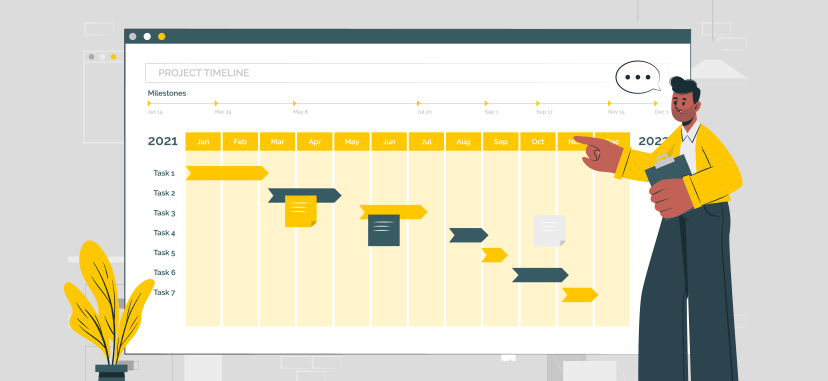
Click the button to start reading
Resource Leveling: Staying Afloat in a Sea of Tasks
You’re in the middle of a project and things are going smoothly. The team is hitting their milestones and everyone is working together like a well-oiled machine. But then you get the dreaded call.
One of your team members is sick and won’t be able to work for the next two weeks. You can already feel the panic rising in your throat. What are you going to do?
This is where resource leveling comes in. Resource leveling is the process of managing resources – such as people, machines, and other resources – to ensure that all tasks are completed on time and with the right amount of resources. It’s like a life vest in a sea of tasks, keeping you afloat when times get tough.
Resource leveling helps you to prioritize tasks based on their importance, as well as to predict when and how much resources will be needed. This way, you can ensure that all tasks are completed in a timely manner without overburdening your team or running out of resources.
But what exactly is resource leveling, and how can you use it to your advantage? Let’s take a closer look.

What’s Resource Leveling?
Resource leveling is the practice of evenly distributing resources across multiple tasks in order to prevent too much or too little from being allocated to any one task.
The goal of resource leveling is to spread the workload evenly between team members, creating a healthy work environment and making the project schedule attainable. It’s also a great way to address any issues with availability of resources, such as if one team member is on vacation or has taken on an extra project.
Resource Leveling Examples
Let’s say you have two people working on a customer support project. One is assigned to work on the customer’s account setup, while the other is assigned to answer calls and assist with account inquiries.
The team member who is answering calls and assisting with account inquiries is getting overburdened by the demand for customer support. The other team member is not as busy and can pick up some of the slack if needed.
Using resource leveling, you could evenly distribute the workload by assigning each team member equal numbers of customer inquiries each day. This would help to make sure that both team members have enough work but aren’t overwhelmed with too much.
Most likely you’re already utilizing resource leveling in some way, but understanding the concept and actively planning your resources is key to ensuring that everyone on your team has enough work without being overburdened.

Four Ways that Resource Leveling Can Help
We’ve identified four ways that resource leveling can help your team stay afloat in a sea of tasks:
- Smoothing out uneven workloads
- Identifying bottlenecks early
- Increasing visibility into project problems
- Addressing scope changes
Smoothing out uneven workloads
Do you have team members who are always running around like chickens with their heads cut off, while others seem to have too much time on their hands? This can lead to frustration and resentment on both sides of the spectrum. Resource leveling evens out these uneven workloads by redistributing work among team members so that everyone has a more manageable workload.
Identifying bottlenecks early
Bottlenecks can seriously derail a project if they’re not identified and dealt with early on. By leveling resources, you can get an early indication of which parts of the project are going to require the most resources. This information can then be used to make adjustments to the project plan so that bottlenecks don’t become a problem later on down the line.
Increasing visibility into project problems
Another benefit of resource leveling is that it increases visibility into potential issues. By looking at how resources are being used (or not used), you can identify potential problems before they have a chance to cause major disruptions. This increased visibility can help you make better decisions about how to allocate resources and avoid potential pitfalls.
Addressing scope changes
If the scope of a project changes, it can often create havoc as far as resourcing is concerned. Resource leveling can help address these changes by determining how best to reallocate resources based on the new scope. This helps ensure that projects stay on track despite changes in scope and helps avoid last-minute scrambling to find additional resources.

7 Super Effective Resource Leveling Tactics
Now that you know how resource leveling can help, let’s take a look at some of the tactics you can use to effectively implement it.
Here are seven effective tactics for implementing resource leveling:
1. Borrow From Peter to Pay Paul
One way to level resources is by “borrowing” from another part of the project that doesn’t need those resources at that moment and using them where they’re more needed.
For example, if you have a team working on two tasks—Task A which requires four workers for two days, and Task B which requires two workers for four days—you might borrow two workers from Task A for the first two days of Task B, and then borrow two workers from Task B for the last two days of Task A. This ensures that both tasks get completed on time without any undue stress on your team.
2. Smash That Silo!
Silos are bad news bears for project managers. A silo mentality can lead to infighting among team members, hoarding of resources, and an overall feeling of mistrust among teammates. If you want your project to succeed, it’s important to encourage collaboration and break down silos early and often.
One way to do this is by creating cross-functional teams—that is, teams made up of members with different expertise who can complement each other’s skill sets. This kind of team environment fosters collaboration and prevents resource hoarding because members know that they need to share resources in order for the team to succeed.
3. The Cake Is a Lie! (Or Is It?)
In project management, it’s important not to promise more than you can deliver—but it’s also important not to deliberately lowball your estimates in order to make yourself look good. Nobody likes being lied to, least of all your project stakeholders.
A better approach is what one PMI member calls “deliberate optimism.” In other words, be realistic in your estimates but also err on the side of caution so that you don’t overcommit and end up disappointing people further down the line.
4. Keep It Lean (And Mean)
In lean manufacturing (and lean management more generally), one of the core principles is eliminating waste throughout the production process. The same principle applies to resource management: if there’s something getting in the way of efficient resource utilization, get rid of it.
This could mean anything from streamlining communication channels so that everyone is on the same page about what needs to be done when, or it could mean ditching outdated processes and tools that are no longer serving a purpose.
5. The Power of Prioritization
If you’re faced with a situation where resources are in short supply, one way to manage it is by prioritizing tasks according to their importance. This can be done manually or via software that can automate this process for you. We recommend Teamly not only for task management and tracking, but also for its powerful resource prioritization features.
By assigning values to tasks according to their importance, you can ensure that the most important tasks are being handled first and resources are not wasted on low-priority tasks.
6. Zoom Out For The Big Picture
It’s easy to get bogged down in minutiae when managing a project, so it’s important to take a step back every now and again and look at the big picture.
Ask yourself: What is the overall goal of the project? Which tasks need to be completed in order for that goal to be met? How can I best utilize my resources so that those tasks are completed efficiently?
7. Don’t Just React – Be Proactive
As a project manager, it’s important to stay ahead of the curve. If you see potential problems looming on the horizon, take steps to address them now rather than waiting for them to become a full-blown crisis.
This could mean having regular meetings with your team to discuss future plans, engaging with stakeholders to ensure everyone is on the same page, or training your team members in different skills so that they can take on more tasks in the future.

The Three Rs of Project Management: Resource Allocation, Resource Leveling, and Resource Smoothing
There are a lot of terms used in project management that can be confusing. In this case, three very similar-sounding terms are often used interchangeably: resource allocation, resource smoothing and resource leveling.
While these concepts all deal with the same idea—getting the right resources in place to achieve a project’s goals—each has its own distinct definition and purpose.
Resource Allocation
This is the process of assigning resources to specific tasks based on their availability and cost. The goal here is to make sure that you’re getting the most out of your resources in terms of quantity, quality, and price.
Resource Smoothing
The focus here is on balancing the amount of work across different areas or people in order to minimize interruptions to productivity. Here, the goal is to avoid peaks and troughs in demand so that your project runs as smoothly as possible.
Resource Leveling
As you know by now, this involves adjusting the timing of tasks and shifting resources around in order to make sure that everyone on your team has enough work but also isn’t overwhelmed by too much work. This helps to ensure that deadlines are met, goals are achieved, and resources aren’t wasted.

5 Types of Resource Leveling Tools Every Project Manager Needs
Luckily, there are plenty of different resource leveling tools out there that can help you keep your project on track. Here are five of the most popular types:
- Gantt Charts
- Critical Path Method
- Resource Allocation Matrix
- Project Management (PM) Software
- PM Templates
1. Gantt Charts
Gantt charts are one of the most popular tools for resource leveling (and for good reason). They provide a clear and easy-to-understand overview of your project, and they make it easy to see which tasks need to be completed when.
Plus, Gantt charts can be used for more than just resource leveling—they can also be used for project planning, task management, and tracking project milestones. In other words, they’re the perfect all-in-one tool for busy project managers.
2. Critical Path Method
The Critical Path Method (CPM) is another popular tool for resource leveling (as well as project management in general).
CPM is all about finding the shortest path from start to finish—which is essential for keeping your project on schedule and ensuring that it’s completed on time and within budget.
3. Resource Allocation Matrix
A Resource Allocation Matrix (RAM) is a tool that helps you assign tasks to team members based on their skills and availability. This is related to resource leveling because it ensures that each team member is working on tasks that they’re qualified to do—which frees up your time so that you can focus on other aspects of the project. RAMs can be created using spreadsheet software like Microsoft Excel or Google Sheets.
4. Project management software
If you’re looking to take your resource leveling to the next level, you might want to consider using project management software. These tools provide powerful tracking capabilities that make it easy to keep an eye on everyone and everything associated with your project.
They also come with a wide range of features, such as task allocation tools, automated notifications, and reporting functionalities—all of which can help you stay on top of your resource levels and ensure that everyone is working efficiently.
We suggest trying out Teamly. It’s free to get started and it has a lot of built-in tools that help keep your team connected and organized. Teamly has realtime chat features, which is great for when you need to keep everyone in the loop about any changes or updates.
It also allows you to assign tasks and track progress, view overall project progress and screen capture capabilities whether you need to make a quick video or capture a picture, you can do it all on Teamly. You can also save time with Teamly’s templates (see next point)
5. Project Management (PM) Templates
Finally, one of the best ways to make sure that your resource leveling is going smoothly is by using project management templates. Templates are pre-made project management documents that you can customize for your needs.
Teamly’s templates make it easy to create project plans, budget sheets, resource allocation schedules, and more—all without having to start from scratch.
They have over 100+ pre-written Standard Operating Procedures (SOPs) and checklists for virtually any business, so your team can easily establish best practices.Use the templates “as is” or edit them to better suit your needs.
Conclusion
Resource Leveling may not be the magic pill that fixes all of your resourcing issues, but it can help you manage your resources more effectively and avoid some of the pitfalls that can occur when you’re over-allocating your resources.
Revisit the tools and tactics outlined in this article to ensure that you have the resources necessary to complete your project on time, on budget, and with the highest quality possible. Best of luck!
















